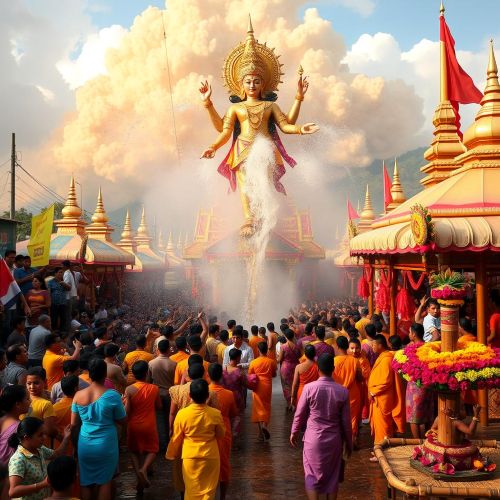Akitu : Mesopotamian New Year
At a glance
| Description | |
|---|---|
| Location | Babylon, Assur, and Ur |
| Country | Iraq, Syria |
| Dedicated To | Marduk |
| Duration | 12 days |
| Time of Year | March – April |
Introduction
Akitu stands as one of the most influential and enduring celebrations of the ancient world. Emerging from the civilizations of Sumer, Akkad, Babylon, and Assyria, this Mesopotamian New Year festival was far more than a seasonal event. It was a carefully constructed twelve-day ritual cycle that reaffirmed the balance of the cosmos, the authority of the king, and the fertility of the land. First observed in the third millennium BCE, Akitu coincided with the spring equinox, though in some traditions it was also celebrated during the autumn harvest.
The festival functioned as both a civic and religious drama. It intertwined mythic storytelling, ritual purification, and communal feasting, drawing entire populations into a performance that symbolically reset the world each year. To the Mesopotamians, Akitu was not just a festivity of renewal—it was the moment when gods and humans realigned, ensuring stability for the year to come.
Connection with Mythology
At its heart, Akitu was deeply bound to Mesopotamian mythology, particularly the Babylonian creation epic Enuma Elish. This foundational myth narrates how Marduk, Babylon’s patron deity, defeated the chaos-dragon Tiamat and established order in the universe. During Akitu, this story was recited and performed to remind participants that the struggle between chaos and order was eternal but ultimately guided by divine will.
The mythic framework of Akitu linked cosmic battles to earthly governance. Just as Marduk emerged as supreme deity, the king of Babylon reaffirmed his divine mandate through ritual acts of humility and restoration. The recitation of Enuma Elish was not a passive ritual—it was a performative reenactment believed to renew creation itself.
Beyond Marduk, Akitu celebrated a pantheon of deities. Earlier forms of the festival honored Nanna, the moon god associated with time, while other iterations included Inanna, Enlil, or Nabu depending on the city. This adaptability demonstrates Akitu’s role as a unifying framework across Mesopotamia, one that could be molded to local traditions while maintaining its central theme of renewal.
Main Activities
Akitu was carefully structured into twelve days, each with a distinct purpose blending solemn ritual and joyous spectacle. The festival began on the first day of the month of Nisan, marking the planting season and the renewal of agricultural life.
The opening days were devoted to purification. Temples were cleansed, and priests recited prayers and laments to prepare the community spiritually. By the third and fourth days, divine statues from neighboring temples were brought into Babylon, symbolizing the assembly of the gods and reinforcing Babylon’s central place in the cosmic order.
One of the most striking rituals occurred on the fifth day, when the king underwent ritual humiliation. Stripped of his royal regalia and forced to kneel before Marduk’s image, the king was symbolically reduced to a commoner. The high priest would slap his face, demanding confession of innocence. If the king wept, it was taken as a sign of divine favor; if he did not, it foreshadowed misfortune for the year ahead. This moment underscored that royal authority was conditional and derived only through the will of the gods.
On the sixth and seventh days, the festival shifted toward mythic performance. The Enuma Elish was recited, and symbolic battles or effigy burnings represented the triumph of Marduk over chaos. The eighth day featured processions, feasts, and sometimes a “sacred marriage” ritual, linking divine fertility with agricultural abundance.
The final days focused on restoration. The king was reinstated with full regalia, divine approval was reaffirmed, and great processions carried the statues of gods to the Akitu-house outside the city walls. Here, the assembly of deities was believed to decide the fate of Babylon for the coming year before returning to their respective sanctuaries. The twelfth day marked the conclusion, as the people celebrated in unity, confident that order had once again triumphed.
Importance in Cultural History
Akitu was far more than a religious festival—it was a cornerstone of Mesopotamian society. Politically, it reinforced the relationship between the king, the priesthood, and the gods. The king’s ritual abasement served as a reminder that power was temporary and dependent on divine sanction. This created a cycle of accountability, where the ruler’s legitimacy was reaffirmed annually through ritual.
Agriculture was another key aspect. Timed with the spring equinox, Akitu invoked divine blessings for fertility and successful planting. In a region where survival was tied to the Tigris and Euphrates, aligning agricultural cycles with divine order was essential for communal stability.
Culturally, Akitu was a unifying spectacle. Citizens of all classes participated in the processions, feasts, and public rituals, experiencing firsthand the myths that defined their worldview. The festival not only reinforced Babylon’s identity as the center of the universe but also provided a rare opportunity for collective celebration.
Historians and anthropologists recognize Akitu as the earliest example of a structured New Year festival. Its blend of myth, politics, and civic life influenced later religious traditions across the Mediterranean and beyond.
International Appeal
Though rooted in ancient Mesopotamia, Akitu’s themes continue to resonate across cultures and centuries. Its emphasis on cosmic renewal, divine kingship, and seasonal rebirth echoes in other traditions such as the Persian Nowruz, the Jewish Passover, and the Christian Easter. All these festivals, like Akitu, center on liberation from chaos and the hope of new beginnings.
During the Neo-Assyrian period, Akitu expanded in scale, with kings like Sennacherib constructing dedicated Akitu-houses outside major cities. Even under the Seleucids and Romans, the festival persisted, adapting to new cultural contexts while preserving its core symbolism of renewal. By the third century CE, variations of Akitu were celebrated as far away as Syria and Rome.
In modern times, Akitu survives as the Assyrian New Year, celebrated each April 1st by Assyrian communities worldwide. While the tone today is more festive than ritualistic, the symbolism of renewal remains central. Parades, music, traditional clothing, and cultural performances bring communities together in Iraq, Syria, the United States, and Europe. For many, Akitu is not just a festival but a statement of identity and resilience, keeping alive a tradition that has endured for over 4,000 years.
The enduring legacy of Akitu lies in its universal themes. Whether through ancient mythic reenactments or modern parades, it embodies humanity’s perennial need to mark time, celebrate renewal, and affirm the connection between the sacred and the everyday.
Source
Bottéro, J. (2001). Religion in Ancient Mesopotamia. University of Chicago Press.
Dalley, S. (2000). Myths from Mesopotamia: Creation, the Flood, Gilgamesh, and Others. Oxford University Press.
Lambert, W. G. (2013). Babylonian Creation Myths. Eisenbrauns.
Pongratz-Leisten, B. (2015). Religion and Ideology in Assyria. De Gruyter.
Oppenheim, A. L. (1964). Ancient Mesopotamia: Portrait of a Dead Civilization. University of Chicago Press.
JM Bidmead. (2002). The Akitu Festival: Religious Continuity and Royal Legitimation in Mesopotamia. https://search.proquest.com/openview/0993656000fd3721a35c685cbfab9e83/1?pq-origsite=gscholar&cbl=18750&diss=y
Contributors to Wikimedia projects. (2006). Akitu – Wikipedia. https://en.wikipedia.org/wiki/Akitu
The Babylonian Akītu Festival and the Ritual Humiliation of the King. (2022). https://anetoday.org/mirelamn-ritual-humiliation-king/
Akitu | Mesopotamian festival | Britannica. (2025). https://www.britannica.com/topic/Akitu
Mesopotamian Kings Were Slapped in the Face in the Ancient Akitu … (2022). https://www.ancient-origins.net/history-ancient-traditions/akitu-festival-002128
VA Hurowitz. (2003). The Mesopotamian god image, from womb to tomb. In Journal of the American Oriental Society. https://www.jstor.org/stable/3217848
Frequently Asked Questions
Lorem ipsum dolor sit amet, consectetur adipiscing?
Lorem ipsum dolor sit amet, consectetur adipiscing elit. Praesent convallis vestibulum justo, ac tincidunt nunc vehicula quis. Nullam id dolor quis orci malesuada feugiat. Curabitur aliquet libero at urna ullamcorper, ac ultricies nulla dapibus.
Lorem ipsum dolor sit amet, consectetur adipiscing?
Lorem ipsum dolor sit amet, consectetur adipiscing elit. Praesent convallis vestibulum justo, ac tincidunt nunc vehicula quis. Nullam id dolor quis orci malesuada feugiat. Curabitur aliquet libero at urna ullamcorper, ac ultricies nulla dapibus.
Lorem ipsum dolor sit amet, consectetur adipiscing?
Lorem ipsum dolor sit amet, consectetur adipiscing elit. Praesent convallis vestibulum justo, ac tincidunt nunc vehicula quis. Nullam id dolor quis orci malesuada feugiat. Curabitur aliquet libero at urna ullamcorper, ac ultricies nulla dapibus.
Lorem ipsum dolor sit amet, consectetur adipiscing?
Lorem ipsum dolor sit amet, consectetur adipiscing elit. Praesent convallis vestibulum justo, ac tincidunt nunc vehicula quis. Nullam id dolor quis orci malesuada feugiat. Curabitur aliquet libero at urna ullamcorper, ac ultricies nulla dapibus.
Lorem ipsum dolor sit amet, consectetur adipiscing?
Lorem ipsum dolor sit amet, consectetur adipiscing elit. Praesent convallis vestibulum justo, ac tincidunt nunc vehicula quis. Nullam id dolor quis orci malesuada feugiat. Curabitur aliquet libero at urna ullamcorper, ac ultricies nulla dapibus.









